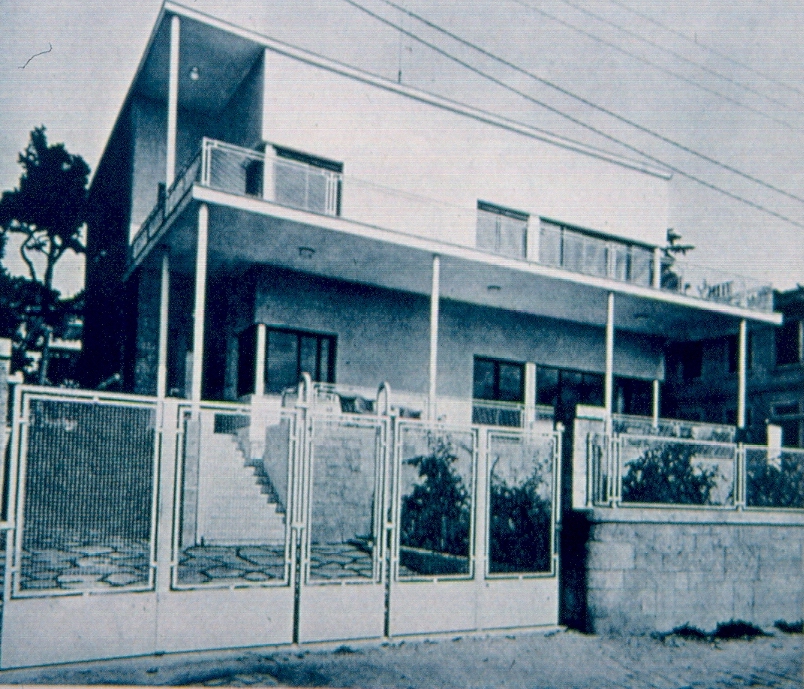Archive
Ragıp Devres Villa
- BuildingResidence
- Ragıp Devres Villa
Word Count: 4
- Ragıp Devres evi, Ragip Devres House
- Ernst Egli
- 1932
Cevdet Paşa Caddesi No. 101, Bebek, Istanbul.
- İstanbul (TR)
The house designed by the Swiss-Austrian architect Ernst Egli for the engineer Ragip Devres in Istanbul Bebek left its mark on the Turkish villa landscape.
Word Count: 25

Ernst Egli, Ragıp Devres House, Istanbul Bebek, Cevdet Paşa Caddesi No. 101, 1932/33, view from the street (Werk, no. 25, 1938). 
Ernst Egli, Ragıp Devres House, Istanbul Bebek, Cevdet Paşa Caddesi No. 101, 1932/33, interior (Werk, no. 25, 1938). Alpagut, Leyla. Cumhuriyet'in mimarı Ernst Arnold Egli. Boyut Yayıncılık, 2012.
Atalay Franck, Oya. Architektur und Politik. Ernst Egli und die türkische Moderne 1927–1940. gta Verlag, 2012.
Cengizkan, Ali, et al., editors. Ernst A. Egli: Türkiye'ye katkılar. Yerel yorumlar, eğitimde program, pratiğin muhasebesi. TMMOB Mimarlar Odasi Birliği, 2017.
Demir, Ataman. Arşivdeki belgeler ışığında Güzel Sanatlar Akademisi’nde Yabancı hocalar. Philipp Ginther’den (1929) – (1958) Kurt Erdmann’a kadar. Mimar Sinan Güzel Sanatlar Üniversitesi, 2008.
Dogramaci, Burcu. Kulturtransfer und nationale Identität. Deutschsprachige Architekten, Stadtplaner und Bildhauer in der Türkei nach 1927. Gebr. Mann, 2008.
Egli, Ernst. Zwischen Heimat und Fremde, einst und dereinst. Erinnerungen. Ernst Egli Papers (unpublished manuscript, Zurich, 1969, ETH Library, Zurich) Hs 787:1.
Gürboğa, Nurşen. “Evin Halleri: Erken Cumhuriyet Döneminde Evin Sembolik Çerçevesi.” Istanbul, no. 41, 2003, pp. 58–65.
Meier, Werner. “So erlebte ein Auslandsschweizer die neue Türkei.” Schweizer Illustrierte Zeitung, no. 37, 1941, pp. 1238–1240.
Nayman, Esma. “Die Stellung der Frau in der neuen Türkei.“ Europäische Revue, vol. 12, 1936, pp. 510–512.
Nicolai, Bernd. Moderne und Exil. Deutschsprachige Architekten in der Türkei 1925–1955. Verlag für Bauwesen, 1998.
Werk, no. 25, 1938.
Word Count: 183
- Istanbul
- Burcu Dogramaci. "Ragıp Devres Villa." METROMOD Archive, 2021, https://archive.metromod.net/viewer.p/69/2949/object/5140-8103245, last modified: 12-04-2021.
-
Alfred Heilbronn Botanical GardenGardenIstanbul
The botanical garden in Fatih was established above the Galata Bridge in historic Stambul in the 1930s. This was carried out at the suggestion of the exiled botanist Alfred Heilbronn.
Word Count: 30
ArkitektMagazineIstanbulThe architecture magazine Arkitekt was an important platform for emigrated architects and urban planners such as Bruno Taut, Martin Wagner, Wilhelm Schütte, Ernst Reuter and Gustav Oelsner.
Word Count: 28
Leonore KosswigBiologistPhotographerEthnographerIstanbulThe exiled biologist and photographer Leonore Kosswig was one of the pioneering women researchers travelling alone in the 1950s and exploring customs and ways of life in Turkey and Iraq.
Word Count: 30
Traugott FuchsPhilologistRomanistPoetPainterIstanbulTraugott Fuchs was a multi-talented philologist, painter and poet who lived in Istanbul from 1934 until the end of his life in 1997.
Word Count: 21